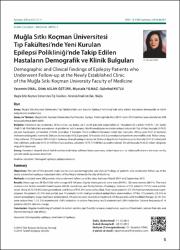Demographic and Clinical Findings of Epilepsy Patients who Underwent Follow-up at the Newly Established Clinic of the Mugla Sitki Kocman University Faculty of Medicine
Abstract
Objectives: The aim of the present study was to evaluate demographic and clinical findings of patients who underwent follow-up at the newly established epilepsy outpatient clinic of the Mugla University Faculty of Medicine. Methods: Included were 208 patients who underwent follow-up at the clinic between March 2014 and September 2015. Results: Mean age was 29.42 +/- 15.86, with a range of 5-84 years. Eighty-three patients were men (39.9%); 125 were women (60.1%). The most common risk factors included head trauma, febrile convulsion, and family history of epilepsy. Seizures of 155 patients (75.5%) were partialonset, those of 22 (10.6%) were generalized, and those of 9 (4.3%) were unclassified. Sixty-seven patients (37.2%) had normal electroencephalogram, 96 patients (53.3%) had partial, and 10 patients (5.6%) had generalized epileptiform abnormalities. Of the 172 patients (28.5%) to whom antiepileptic drugs had been administered, 49 were resistant to medical treatment. Of the patients with modified therapy, 22 (41.5%) were seizure-free, 7 (13.2%) experienced >50% reduction in seizure frequency, and 8 experienced <50% reduction. Seizure frequency of 16 patients (30.2%) did not change. Conclusion: Regular monitoring of patients in certain centers significantly increases compliance, success of treatment, seizure-free rate, and the monitoring of side effects.
Source
EpilepsiVolume
22Issue
1URI
https://doi.org/10.5505/epilepsi.2016.66487https://app.trdizin.gov.tr//makale/TXpFM09Ua3hNUT09
https://hdl.handle.net/20.500.12809/2797


















